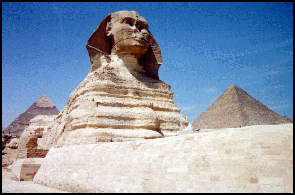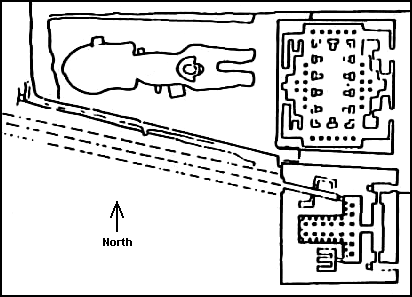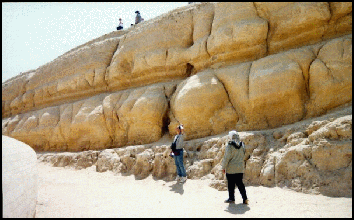
© Photo copyright Larry Orcutt

© Photo copyright Larry Orcutt
The Great Sphinx on the Giza Plateau was not built, but rather carved from the limestone bedrock. Conventional techniques of dating the Sphinx have included analysis of its stylistic features, the stratigraphy of artifacts excavated, and the record of extant historical documentation.
In my opinion, the most compelling evidence that the Sphinx dates to the time of Khafre is found in the layout of the Sphinx enclosure (see diagram below). If we assume that the Sphinx was carved in Pre-Dynastic times, then we might well wonder why the southern wall of the enclosure was carved at an angle. Why wasn't it squared with the axis of the Sphinx as were the other walls? Further, if it is assumed that the southern wall was capriciously carved at the angle we find it, then isn't it a bit too much to expect that thousands of years later, after the construction of tombs and pyramids on the surrounding necropolis, Khafre was able to build his pyramid and his valley temple, and then have the angle of the causeway connecting the two match exactly the angle of the southern wall of the enclosure? This would have been quite a providential coincidence indeed. One might counter that perhaps the southern wall of the enclosure was at first parallel with the axis of the Sphinx and then later modified by Khafre to accommodate his causeway. But in that case, the southern wall wouldn't show the alleged "ancient" erosion pattern (see photograph below), nor would the allegedly Pre-Dynastic Sphinx Temple be off-center in relation to the Sphinx but centered in relation to the "modified" southern wall.
Plan of Khafre's causeway and the Sphinx enclosure.

Plan after Lehner, 1991
Recent controversy has resulted primarily from a geological examination of the monument. The darling of the old-Sphinx theorists remains Dr. Robert M. Schoch, associate professor of science and mathematics at the College of General Studies at Boston University. He was contacted in 1989 by John Anthony West, who needed a geologist to test his theory that the Sphinx dates to 10,500 BC or earlier. Schoch visited Egypt in 1990 and again in 1991 and came to agree with West that, based on the geological evidence, the Sphinx dates to well before the Fourth Dynasty, though not as early as West would have it. Schoch detailed his reasoning in his book Voices of the Rocks (Harmony Books, 1999), and it is from this book that I shall quote his arguments.
According to Schoch, proof that both the Sphinx Temple and Khafre's Valley Temple predate the Fourth Dynasty is found in the granite blocks (below misnamed "ashlars") that were used to face the large limestone blocks:
The limestone blocks cut from the Sphinx enclosure showed the uneven surface expected from long-term weathering. The granite ashlars had actually been shaped to fit these undulating surfaces. [pp. 36-37]
He reasoned that because the Egyptians would not use weathered limestone to build the temples, and because the granite facing was applied in the Fourth Dynasty to the weathered limestone, then "the limestone predated the granite by a considerable period." [p. 37] There are a few problems with this reasoning. First of all, the Egyptians did not ordinarily finish granite stones to a smooth surface on the side that would not show. Such detailing would be unnecessary, and the labor involved would have been wasteful. In a similar vein, it seems extremely unlikely that the harder granite stone would be cut to fit the limestone. Would not the reverse be more logical, the softer limestone cut to accommodate the granite? Indeed, the limestone core blocks of Khafre's Valley Temple were smoothed to allow a flush fit of the granite casing. Core material was not finished to perfection, nor was it made of the finest materials, as it would be hidden by the casing. It must also be remembered that the granite facing stones were refitted in modern restorations, a factor that further clouds the situation as it exists today.
Schoch saw two distinct weathering processes at the Sphinx enclosure: wind and rain erosion. He wrote:
The Sphinx showed some wind erosion, particularly on the head and upper back, which sit above the ground level of the plateau. However, the Sphinx also displayed obvious and extensive wear from precipitation. Rock worn away by rain has an undulating surface, often displaying distinct vertical crevices. This kind of erosion is well developed and prominent on the body of the Sphinx and within the Sphinx enclosure, where the weathering reaches from over three feet to more than six feet deep below the surface. Even though certain of the Giza structures are built from the same kind of limestone as the Sphinx, none of them show the same degree of precipitation-induced weathering. [p. 39]
Sphinx limestone strata.

Diagram after Lehner, 1991
What Schoch fails to mention is that the quality of the limestone in the area of the Sphinx varies. The Sphinx is carved out of limestone bedrock containing three strata: Members I, II, and III. Member I is very hard and comprises the lower portion of the Sphinx. The head of the Sphinx is carved from Member III which is also hard (it was quarried for the core blocks of the Giza pyramids). The middle stratum, Member II, is made up of poorly consolidated limestone that is easily erodable. The quality of the limestone is so poor that the body of the Sphinx had eroded significantly by the time of the New Kingdom, and has continued to erode since. Schoch is vague about the certain "Giza structures" cited above, but elsewhere he has mentioned that the Tomb of Debehen shows no such erosion though it was supposedly contemporary to the Sphinx. Unfortunately, Schoch ignores the fact that the tomb lies some 75-141 feet higher on the Giza Plateau and is carved from the more durable Member III limestone. More recently (in KMT 5:2, 6), Schoch uses the rock-cut tombs of the eastern escarpment as a similar example. Again, though the tombs may be at a like elevation, they are cut from a different layer of limestone and thus bear no valid comparison with the limestone of the Sphinx enclosure.
Giza limestone strata.

Diagram after Lehner, 1991
Schoch gives further evidence for his thesis:
Interesting corroborative evidence come from the Saqqara Plateau, located about ten miles from Giza. At Saqqara, a number of fragile mudbrick tombs called mastabas are dated indisputably to the First and Second Dynasties, several hundred years earlier than the Sphinx's putative 2500 B.C. origin. None of these tombs bears the marks of the kind of rain-caused weathering seen on the Sphinx and the Sphinx enclosure. In fact, the mastabas were preserved by being buried in dry, windswept sand. [p. 39]
Most of the mudbrick tombs of Saqqara had indeed weathered away save those portions that were preserved under the fallen debris of the superstructure. The "preserved" mastabas were only exposed in the last century, and that is the very reason why there were preserved. Also, while the Sphinx enclosure lies at the drainage point of much of the Giza necropolis, the tombs at Saqqara are high on the desert plateau and thus in a drier place regardless of rainfall.
Schoch observed that the Sphinx enclosure is weathered unevenly:
The north, south, and east floors of the trench surrounding the east-facing Sphinx are weathered to a depth of six to eight feet below the level of the enclosure's currently exposed surface. On the monument's western end, the Sphinx's rump, the weathering extends to only four feet. [p. 40]
Schoch concludes that the Sphinx was carved in two stages: the Sphinx's head and main body in the first stage, and the Sphinx's back end in the second stage (possibly as a part of Khafre's reconstruction). James Harrell, a professor of Geology at the University of Toledo, Ohio, offers another reason for the uneven weathering: the quality of rock differs from the west to the east as the limestone strata dips.
In a personal correspondence, Lambert Dolphin, a geophysicist who has worked within the Sphinx enclosure, addressed the question:
The work of Schoch and West on the Sphinx is highly flawed. For one thing they ignored the severe local atmospheric industrial pollution in the last century which has severely damaged the Giza monuments and fast, too. This is well known by the Egyptologists. I won't get in to that story, you probably are up to date on their work and the many thorough refutations from well-qualified people.
Southern wall of the Sphinx enclosure.

© Photo copyright Larry Orcutt
The walls of the Sphinx enclosure are badly weathered, and this is cited by Schoch and West as supportive of their "old-Sphinx" theory. Though the vertical fissures appear to have been the result of water, other factors may have had an influence in their formation. There may have been jointing in the parent material that may have been opened by the effects of wind-borne sand particles and temperature differentials. It could also have been that carving techniques, the use of mallets and wedges, resulted in uneven stress being applied along the cut face resulting in cracking that was augmented by both wind and water erosion. Even while sand covered the bulk of the Sphinx, following heavy rain or flooding (which still occurs today) the wet sand might well have accelerated weathering. Salt crystal exfoliation may have also played a part (for a more detailed explanation, see geologist August Matthusen's rebuttal to the "old-Sphinx" theory). Paul Jordan's excellent book, Riddles of the Sphinx (New York University Press, 1998) offers a good academic overview of the controversy (pp. 145-161).
Diagrams above were cribbed (and modified) from Mark Lehner's Yale University doctorate dissertation, Archaeology of an image: The Great Sphinx of Giza, © copyright Mark Lehner 1991.
Catchpenny Mysteries © copyright 2000 by Larry Orcutt.